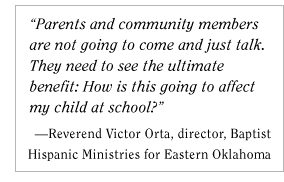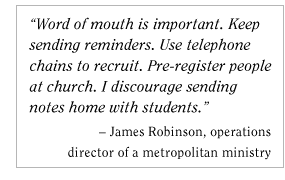|

Recruitment
can make or break the success of any community forum or public discussion.
Here are some strategies from experienced organizers worth considering.

Enlist community members who are respected and valued in the community
to help promote a public forum by word-of-mouth. One of the best
recruiters might be a local parent who is well known and liked by
the parents of children who attend a neighborhood school. Another
good source is a local minister or priest who can recruit his or
her congregation. Post a list of neighborhood recruiters with the
most up-to-date contact information so that you can call on them
when necessary.

 It's
important to explain what you hope to accomplish during the discussion.
Do you want ideas from the community on how to improve schools?
Do you want feedback on whether parents think a proposed school
improvement effort is a good idea? Do you want to measure parents'
attitudes about public schools? Participants will want to know what
their role is during the discussion. This will help them decide
whether it's worth their time. It's
important to explain what you hope to accomplish during the discussion.
Do you want ideas from the community on how to improve schools?
Do you want feedback on whether parents think a proposed school
improvement effort is a good idea? Do you want to measure parents'
attitudes about public schools? Participants will want to know what
their role is during the discussion. This will help them decide
whether it's worth their time.

Local community leaders are best equipped to help organizers identify
print, radio and television outlets with target audiences of ethnic
and minority groups. Consider asking a Spanish-speaking radio or
television station to run public service announcements promoting a community
forum. Ask the editor of a neighborhood newspaper designed for African-American
or Asian readers to consider running an article or inserting a flier
in the newspaper. Approach the publisher of a free community newsletter
to help spread the word about an upcoming event.

 Survey
community leaders and find out where parents, community members
and others congregate. Go there. Leaflet restaurants, churches,
temples, restaurants, neighborhood grocery stores, mini-marts, billboards,
popular national discount chains, laundromats, community centers,
farmers' markets and other locations. Pass out fliers at local festivals
celebrating Diez y Seis de Septiembre, Juneteenth, Chinese New Year
and other cultural and ethnic holidays. Survey
community leaders and find out where parents, community members
and others congregate. Go there. Leaflet restaurants, churches,
temples, restaurants, neighborhood grocery stores, mini-marts, billboards,
popular national discount chains, laundromats, community centers,
farmers' markets and other locations. Pass out fliers at local festivals
celebrating Diez y Seis de Septiembre, Juneteenth, Chinese New Year
and other cultural and ethnic holidays.
 |
 |
 |
 |
 |
 |
 |

Invite minority groups to help design materials
Community outreach staff who work with religious groups,
human service agencies or schools can provide pointers on
creating promotional fliers, newsletters or brochures. Materials
should also be in forms other than print for those who cannot
read or write. Ideas include videos, public service announcements
or word-of-mouth invitations.
Ask community leaders for help with language
Ask leaders for advice on the best way to word fliers, brochures
or newsletters for a specific audience.
Translate materials in different languages
If you are recruiting members of a Vietnamese-speaking community,
print fliers in Vietnamese. If you are recruiting Native Americans,
print materials in their languages. Simple, right? Well, not
always. Some ethnic groups have more than one language. For
example, there are more than 500 Native American languages.
Since many indigenous languages are not written, promoting
recruitment by word-of-mouth instead of print form may need
to be considered. Be aware of the different languages and
dialects in your community.
Keep it simple
If a sixth grader can't understand what you've written, it's
too complicated. Avoid education jargon.

One community leader, who works for the Red Cross and raises
awareness among Native Americans about AIDS, likens community
forums to "talking circles," a Native American custom. This
custom involves members of a group passing a talking stick
from one person to the next. Whoever holds the stick, speaks.
Each person takes a turn sharing their thoughts. The community
leader says it's an effective way to involve everyone in the
conversation.
|
 |
 |
 |
 |
|